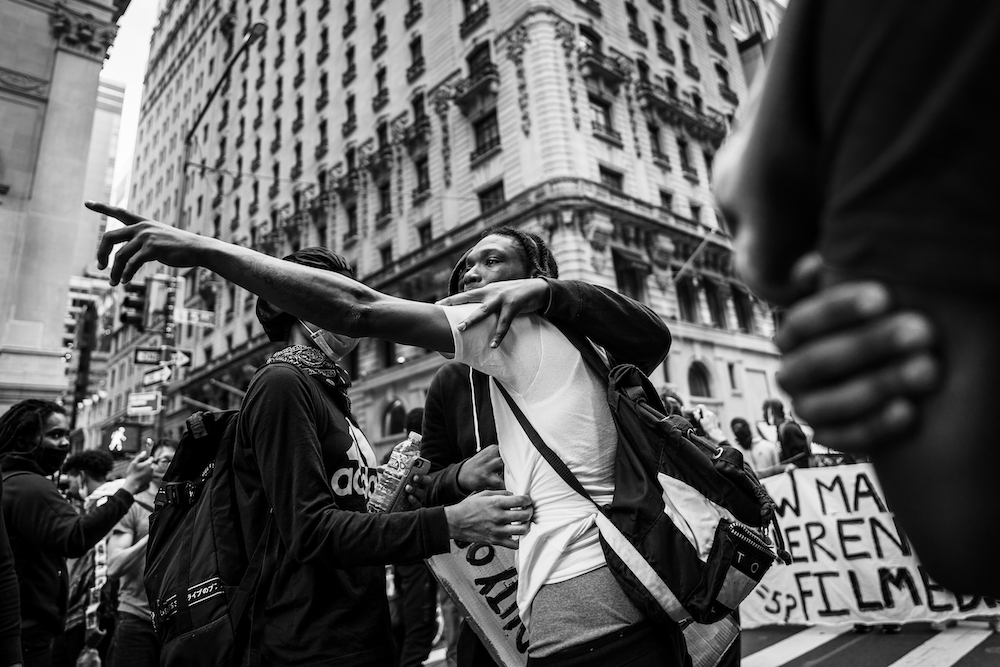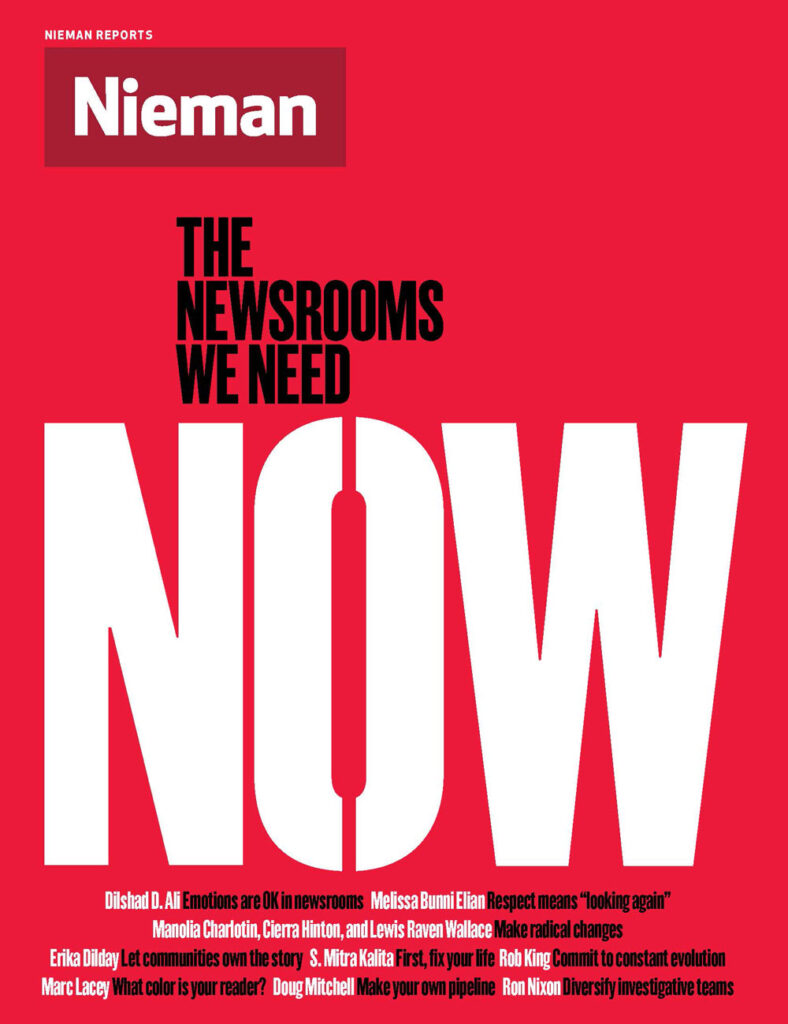On July 19, Black Lives Matter Toronto activists held a press conference about the release of three demonstrators from police custody in connection with pink paint that had been thrown on three statues — including one of Ryerson University’s namesake, Egerton Ryerson, a 19th century Methodist minister and education advocate — for their associations with racism, colonialism, and violence (the other statues were of King Edward VII and Prime Minister John A. Macdonald). In a viral three-minute video clip, Rayvn Wngz, a Black trans woman, riffed on the media.
“We have tried many different ways to get the attention and the conversation of those in leadership roles and positions. It took us having to [vandalize a statue] to get y’all to show up,” she said, speaking directly to the press in attendance. “It’s really ridiculous to me that we’re still talking about monuments.”
It’s been two months since the resurgence of the Black Lives Matter movement, and protests are still going strong around the country, though many don’t catch the attention of national news outlets unless there is conflict, property destruction, or civil disobedience. This is exemplified in Portland, where protests never ended, but interest has only been renewed as federal troops have been sent to control the growing crowds.
Beyond the direct moments of confrontation, which are only a fraction of what’s happening on the ground, there’s so much more going on that tells a more complete story of the uprising.
When the board of the Authority Collective, an affinity group of gender-expanding individuals and women of color who work in lens-based professions, released our Do No Harm statement, we asked image makers to consider Black protestors as a vulnerable group worthy of the protective precautions journalists often employ when reporting on at-risk groups. We also provided suggestions of different moments to focus on in addition to moments of conflict at protests. We saw how the focus on vandalism, destruction, and police confrontations dominated the first few weeks of the Black Lives Matter uprising. We said, “by only emphasizing conflict over collaboration and community, you fail in your duty as a witness, a truthful storyteller and a concerned citizen.”
As news photojournalists, we do our best to avoid illusion and misrepresentation. We understand the limits of our frame so, for context, we aim for photo essays. We also know that capturing an iconic moment can catapult one’s career, which can inform many of our instincts about who, what and how to photograph. There are some photographers who go into these moments for the action shot—for the prize—which results in overlooking the meaning of the in-between, the interstitial muscle that keeps everything in motion.
So, when photographers and photo editors choose to lead the story with destruction and conflict, they leave behind countless other images that signify what this moment is about for the people who live with oppression every day, which should be the actual focus if that oppression is to be eradicated.
When David “Dee” Delgado, a Bronx-based Afro-Latino photojournalist, set out to cover the George Floyd protests in New York City, he expected more of the peaceful protests that he’s been covering since the beginning of the Black Lives Matter movement. But once he saw the protesters directly challenging the police, disobeying orders and defiantly walking up to them, he knew this time would be different. The anger was palpable.
On the second night of curfew, as the eight o'clock deadline approached, Delgado and a few other photographers he often works alongside were following a group of protestors planning to defy the police’s citywide curfew order. That’s when a white photographer made a remark Delgado says was “burned into my memory.”
Delgado recognized that the protestors “didn’t want to start trouble” but that one man was seeking revenge. “He was like, ‘There goes Trump Tower. Let’s set it off on these m*********ers.’” That’s when a white photographer remarked, “‘There goes an instigator,’” Delgado says. Delgado saw the man was visibly intoxicated and holding a liquor bottle. He saw something more and captured a different rendering of the pre-curfew moment.
“The white photographer is looking at him like an instigator, a troublemaker, and I’m not looking at him that way,” Delgado says. “I’m looking at him as, This is a guy that’s hurt, and he has no other way to vocalize that hurt but with rage. [The white photojournalists] started photographing him angry and trying to antagonize the crowd. I photographed him when the crowd was calming him down and talking to him and telling him that that wasn’t the way. [White photojournalists are] only looking for the anarchy.”
Black photojournalist Dee Dwyer has a similar story. “I can see they saw dollars and awards instead of using that time to understand the moment while they photographed,” she remarks of an incident in which she says two white visual journalists tried to push her out of a prime spot to document a protest. “I feel if you’re genuine and care about what you’re documenting, especially in a time like this, you would not do those things. For them, it’s just their money shot. For Black photographers like us, it’s for the culture.”
Photojournalism requires a variety of techniques for various circumstances, spot news coverage being one of them. But spot news is a skill, not a permanent mandate of the profession. And from the standpoint of visual communication, it’s wholly inadequate on its own.
In the past, it may have been enough to shock people into caring, but in our modern era of news fatigue and desensitization the shocking has diminishing value. The problems we face in this Age of Emergency are prolonged, systemic and nonstop. A spot news mentality is great in the heat of the moment, but can become quickly detrimental when used as the only approach to capturing events that stem from a chronic issue. Protests are often in response to longstanding freedom struggles and systemic issues, so it may help photographers to adopt systems thinking.
Systems dynamics, the study of the interconnectedness of life, employs a “continuous view” when approaching problems. It’s a perspective where “events and decisions are seen as surface phenomena that ride on an underlying tide of system structure and behavior,” according to the Systems Dynamics Society. This is especially important when visualizing social movements led by people who are overlooked. The news media’s emphasis on conflict is part of a feedback loop that maintains stereotypes about the Black experience in America. Photographers of color are acutely aware of this dynamic and often create work to counter narrow and incomplete narratives.
Some people would consider this a bias but, really, it’s an informed perspective that can be duplicated by out-group members—that is, white photographers—who use a continuous view to contextualize moments of spot news.
Social work researcher and author Joy DeGruy explains it another way: Respect. In her research of African-American male youth, she discovered that, after victimization and witnessing, the third highest marker for violence is a lack of respect, which she reminds us is derived from the Latin meaning ‘to look again’. Looking again is the difference between catching a Black person in a moment of anger and staying around long enough to see that person’s anger turn into anguish and then into tears.
When photographing protracted struggles, the story can’t always be told in the heat of the moment. When our images are myopic, so is the overall framing of our news stories. Similar to a camera’s lenses, the frameworks we use in our work must be interchangeable.
Melissa Bunni Elian is an independent visual journalist and a board member of the Authority Collective.
The Newsrooms We Need Now
As American society—and American newsrooms—grapple with an unprecedented time in the country’s racial justice movement, Nieman Reports is publishing a series of essays about how journalism should respond to the challenges of the moment, from accelerating journalists of color moving into senior decision-making roles to improving coverage of racism and white supremacy.




